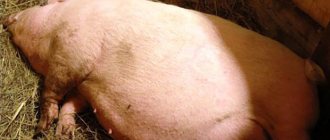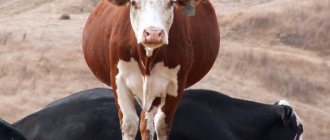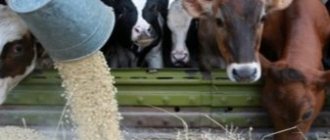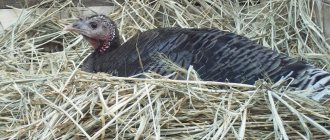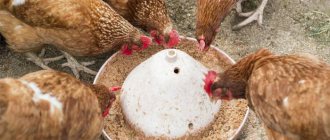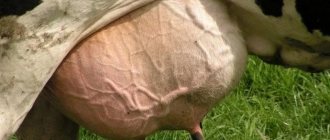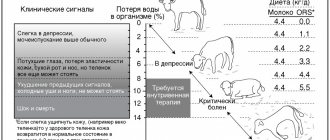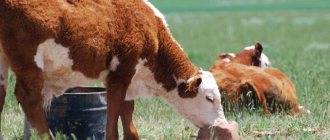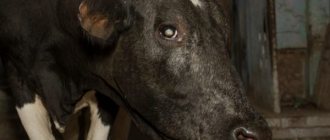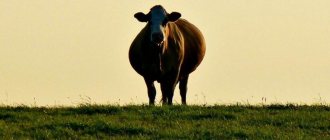Length of pregnancy
Approximately 285 days or 9 months is the same period as in humans for normal pregnancy in cows. It is considered normal for animals when this period shifts in one direction or another. This usually happens because it is not known exactly when pregnancy began. The gestation period depends on a number of factors, which include:
- Animal nutrition during pregnancy. With an acute deficiency of vitamins, pregnancy can be significantly shortened. A reduction in gestation time is also observed when the fetus is too large.
- Level of care for the animal during this period.
- How pregnant is the animal?
- Features of the animal breed.
- The gender of the calf, but this is more of a hypothesis: presumably the heifer may be born a few days earlier.
- Being stressed for a long period of time.
Important! It was noted that 6% of all calvings occur on day 240.
A calf may not be viable if it is born before 140 days and is considered a miscarriage. This occurs due to various diseases in the cow, especially if they are related to the reproductive system. Miscarriage is not excluded during long journeys to distant pastures, as well as after a poor examination. In addition, hormonal imbalances are possible in animals. This even happens due to changes in weather, often due to taking certain medications.
How long does a cow's pregnancy last and carry a calf?
From 9 months, a cow can bear offspring. Although experienced livestock breeders are in no hurry to immediately take her to mating. Often they wait until the animal reaches physical maturity.
It is difficult to give an exact figure for when this will happen. It all depends on the breed of the animal, its maintenance and feeding. The animal is ready for mating if the weight is at least 60% of the weight of an adult animal. This period occurs only in the third year of the animal’s life.
Why do you need an exact gestational age?
Why should farm owners know whether a cow is pregnant, or, as they correctly say, pregnant, and how many months her interesting state lasts? The fact that pregnancy requires care is understandable.
In addition, a pregnant cow can be timid and sometimes loses her fetus due to severe stress. But that's not the main thing
A cow that is pregnant with a calf must undergo a dry period. That’s why it’s so important how long she’s been pregnant, you need to know the exact gestational age
What is the dry period
Before giving birth to a calf, the animal gains strength and rests. To prevent the cow's body from becoming depleted and nutrients being deposited on the body, the cow is stopped being milked before giving birth. How long does the dry period last? Not so long - from 45 to 60 days. But it is advisable that it is not too short. Pros of a long period:
- maintaining the health of the animal;
- milk yield will be maintained in the future;
- the calf will be born healthy.
If the dry period lasts 45 days, then milk yield will decrease in the future. The quality of the milk will also suffer: it will be low in protein and fat.
How to transfer to dry wood
The start of a cow is done 7.5 months after its fertilization; this period must be observed. Before you start a cow, you need to properly organize its nutrition. If the animal's milk yield has already decreased and it produces 3-4 liters of milk per day, it is started immediately. If milk yield is still high, this is done gradually. We need to reduce the number of milkings. Change the feeding regimen:
- do not feed succulent or concentrated food;
- reduce the amount of water;
- reduce the amount of feed;
- give low-nutrient hay or straw;
- if the pregnancy was in the summer, it cannot be kept on pasture for a long time. The animal is released to graze only for 4-5 hours, after which they stop milking for 6-8 days.
As soon as the animal's milk has disappeared, return to the previous feeding regimen. This is not done right away. Over the course of 6-11 days, succulent and concentrated feed is gradually added to the cow’s diet.
Dates of pregnancy
Experienced livestock breeders note that pregnancy or pregnancy in an animal lasts 9 months. To be more precise, a cow is pregnant for 285 days. But, like a person, a cow can have premature births, the timing is approximate.
If she was poorly cared for or fed incorrectly, the calf is born a couple of days or even a month earlier. Sometimes she stays pregnant longer than expected, post-gestating the fetus by several days or even weeks. Therefore, they say that the duration of pregnancy in cows is 240–311 days.
How to calculate the exact gestational age
With artificial insemination, the farmer knows the date of fertilization of the animal. Remembering how long a cow’s pregnancy lasts, how long she will be pregnant, they will find out the approximate date of birth using the formula.
D = H+10 / No. – 3
It needs to be decrypted. D is the date when childbirth is expected. The letter H indicates the number when insemination took place, and No. is the number of the month when insemination occurred.
Let's assume the insemination took place on May 15th. To the number 15 we add 10. It turns out 25. May is the 5th month. We subtract 3 from it. It turns out 2. The cow will calve on February 25th.
If the day of the month, when added, received a figure that is greater than 30, then we subtract 30 from it, and add another 1 to the month. So, if she was inseminated on May 25, then 25+ 10 = 35. The month is also 2. (5-3 ). But we do it as described above: 35-30 =5.
And by the month we add 1. Then the cow will calve on March 5th. If the month number is 3 or less (January, February, March), then 12 is added to the month number. Animal owners often make a calendar so as not to forget when to start stagnation of the cow.
It makes it clear how long she carries the calf and how long the pregnancy lasts. In one column the date of insemination is indicated, in the other - the approximate time of calving. But it is impossible to accurately guess this date. Therefore, a deviation of 10 days is normal.
Norm and permissible deviations
Postmaturity or the birth of premature offspring occurs in cows in the same way as in humans. Of course, one can confidently speak about the presence of this or that deviation only when it is known exactly when fertilization occurred. In all other cases, all you can do is wait. In general, the duration of pregnancy in cows can last from 240 to 311 days.
As soon as fertilization has occurred, a pregnancy and calving calendar is given to the cow. The approximate calving date is calculated from it, and the gestational age is also monitored here. Postmaturity of the fetus is easy to determine using this calendar. It is normal for the baby to be post-term for up to 15 days, this is understandable. Even when the exact number of fertilization is unknown. If it is noticed that the cow has been walking for more than 3 weeks, then the intervention of a veterinarian is necessary. Postmaturity is quite acceptable for cows; according to statistics, this happens in 10% of all cases. The cause of postmaturity can also be hormonal disorders and delayed fetal formation. The last factor depends on the individual characteristics of a particular cow.
How to determine pregnancy? Signs
There are several practical ways to determine if cattle are pregnant. If laboratory testing is not possible, you will have to carry out the procedures at home.
Ultrasound examinations are considered the most accurate.
In the early stages, the pregnancy of a cow is determined after a visual examination of the individual and by observation.
One of the signals will be increased appetite. If previously the animal led an active lifestyle, now peace and tranquility can be seen.
Much depends on character, but most cows do become more settled. This is reflected in their habits.
The farmer can also identify mucous secretions. They do not always appear in the early stages, but it is imperative to monitor them.
Three weeks after conception, special test strips will be effective. After four weeks, a biochemical analysis is recommended.
An increased amount of progesterone is observed in the blood (as in women). After an ultrasound, the question of pregnancy is resolved by itself.
During the early diagnosis stages, you can also conduct a small experiment at home without equipment. Fresh milk is diluted with alcohol tincture (at least 95%).
If the animal is in position, the clotting time is significantly reduced from 30 minutes to 6.
It will be possible to examine the abdomen only in the middle term. After 20 weeks from the moment of fertilization, apply a few light pressures on the right side.
If a calf is born there, its movements will be noticeable.
Do not hurt the animal under any circumstances, as sensitivity is significantly increased in this position. Avoid exhaustion and remember the role of nutrition during pregnancy.
In the last months of pregnancy, vaginal discharge takes on a rich yellowish color, and its quantity also increases.
A month before the expected birth, the right side visually protrudes. This speaks of an upcoming event.
The heifer's udder must also be prepared for lactation. To do this, learn simple massage techniques.
The main condition is that the animal must trust and relax during the procedure. Upon completion of the manipulation, the nipples are kneaded, through which the calf will receive the required amount of natural nutrition.
Every day you should spend at least 5 minutes on the procedure.
Rectal examinations
A rectal examination of cows for pregnancy is carried out by a veterinarian, since he knows what changes the uterus in animals undergoes after fertilization. The doctor has extensive experience and will not harm the cow during the examination.
The veterinarian treats his hands with disinfectant solutions and puts on high sterile gloves. His assistant fixes the cow's horns. At this time, the veterinary service worker moves the animal’s tail to the side and carefully inserts the brush into the anus.
A rectal examination can determine:
- change in the size of the uterus,
- study the shape of the reproductive organ;
- wall consistency;
- density;
- location in the peritoneum;
- condition of the ovaries;
- palpate the corpus luteum (in the early stages of pregnancy);
- examine the cervix.
The veterinarian is able to accurately determine pregnancy at the earliest stages, in the first month after fertilization.
Attention! When performing a rectal examination of a cow, you should be extremely careful not to provoke an increase in uterine tone and not to cause injury to the animal. At the moment of muscle contraction, you should stop moving your hand to avoid internal tears.
Insemination
Insemination of cows can be:
- Artificial. This is the most preferred option. In this case, it is possible to use higher quality seed material, and this method also minimizes the possibility of contracting some disease inherent in cattle. Artificial insemination is much more effective, and the exact date of fertilization is always known. The procedure should only be carried out by a professional. It is believed that artificial insemination can even extend the lactation period of an animal.
- Natural. This is the spontaneous mating of a cow and a bull. Mating needs to be controlled: it is important to correctly determine when the cow comes into heat. As soon as this happens, no later than 12 hours later you need to have time to mate.
Definition of pregnancy
If the fact of insemination itself has not been recorded, then in the very early stages pregnancy in cows is difficult to determine. You can try to establish it by the following signs:
- Animal behavior. In particular, it is noted that after successful mating, cows become calmer and more careful.
- Increased appetite, sometimes even several times.
- Changes in conformation, such as increased smoothness of the coat.
- One of the most recognizable visual signs is the presence of mucus on the external genitalia.
Important! The veterinarian accurately determines the onset of pregnancy by examining the rectum.
Harbingers of childbirth
As the end of fruiting approaches, the cow's body undergoes a number of changes, the significance of which lies in its adaptation to the implementation of the birth act.
Precursors of childbirth include:
- Transformation of the cow's pelvis into a “birth pelvis”, during which the pelvic apparatus relaxes. All pelvic ligaments become loose; their length increases by 1/3 or ¼. In this case, the ischiosacral ligament, when pressed in the area of the subcaudal fold, is felt in the form of a dense, stubborn cord. If you grab this ligament with your fingers before giving birth and pull it to the side, it moves easily. The depression between the base of the tail and the ischial tuberosity increases (“recession of the sacrum”). Usually the pelvis becomes “birthing” 12-36 hours before the start of fetal excretion, but in some animals the ligaments relax only just before birth or 2-3 weeks before birth.
- The cow's labia become enlarged and swollen; their skin becomes smooth, folds straighten out.
- Before childbirth, thick, sticky vaginal mucus thins. The mucus plug that covers the cervical canal dissolves and is released in the form of “leashes,” which are stringy threads of transparent mucus hanging from the external genitalia. Liquefaction of vaginal mucus and “leash” is observed 1-2 days before birth. In cows, “leashes” sometimes appear at the end of the fourth or fifth month of pregnancy.
- Usually 2-3 days before birth, colostrum is released, but it can happen earlier, during or only after childbirth.
- Elevated body temperature during the last month of pregnancy, 12-50 hours before birth, decreases by 0.4-1.2 degrees.
Shortening of the cervix over the next 2-3 hours indicates the beginning of its dilatation and the onset of labor.
Progress of pregnancy
All that a pregnant cow needs in the first trimester is a balanced, complete and sufficient diet, as well as a calm environment and absence of stress. From 60-70 days of pregnancy, the dry period begins, it is characterized by the fact that milking of the cow stops. The animal should get proper rest and prepare for the birth of the calf. Lactation, which follows calving, requires a lot of strength and vitamins, so the cow needs to gain all this during the dry period. Otherwise, she will not be able to properly feed the calf; she will be too exhausted for this. Also, the transition to dry crops allows you to maintain further milk yield at the proper level. Even shortening the dry period to 45 days has a negative effect - the amount of fat and protein in milk is greatly reduced.
However, abrupt cancellation of milking is not recommended. This is fraught with the development of mastitis and other udder diseases. The number of milkings should be reduced gradually. A smooth transition to twice-daily milking and then to one-time milking is recommended. Each of these periods should last 3-5 days, then you can stop milking altogether. When milking is canceled and milk ceases to be produced at all, this is a clear sign that the cow must be switched to a special diet.
How to find out the gestational age of an animal yourself?
You can check cows for pregnancy at home, using folk knowledge. Even a beginner in cattle breeding can use folk remedies. They do this in several ways:
- check the pregnancy of a cow using its milk;
- determined by external palpation of the abdomen;
- look at external changes.
One such sign that a cow is pregnant at an early stage is the mucus secreted by the reproductive organs. Diagnosis of whether a cow is pregnant at home can be done manually by external palpation of the belly. The best time to check whether the cow is fertilized is early in the morning. Determination of pregnancy in cows is carried out on an empty stomach. If the animal eats, the result may not be accurate. You can find videos on the Internet and learn how to conduct a manual examination, but beginners are not recommended to carry out such an examination on their own.
Another method of determination is the milk of a pregnant cow. There are two ways:
- carrying out laboratory analysis of milk at home;
- analysis of progesterone levels in milk in laboratory conditions.
To independently determine if a cow is pregnant and begin preparing for childbirth as quickly as possible, take a little milk and mix it with alcohol in a 1:1 ratio. If the milk has curdled, then it’s time to change the concept of care. Naturally, in laboratory conditions, milk will undergo a more in-depth test.
Diet
During the dry period, the diet of a pregnant cow should be slightly different from usual. Here, too, you need to adhere to gradualism; you should not suddenly change all the animal’s usual food to a completely new one. The transition takes place within a week. The most important difference between this diet is the exclusion of green and concentrated feed. The amount of water fed to the cow is also significantly reduced. During the dry period, a pregnant cow needs to walk in the fresh air. A large amount of vitamins should also be present. Walking should be a joy for the animal, it should not get tired. In the fresh air, oxygen saturation is rapid, and muscles are maintained in the necessary tone.
The diet is based on high-quality hay and roughage; during this period, flax seed cake, wheat bran and oatmeal are added to the cow’s food. It is important to stick to the golden mean, since both obesity and underweight are equally harmful for a pregnant cow. The cow should receive protein, fiber, carotene, calcium, table salt, chalk and phosphorus, all in strictly balanced quantities. It is determined based on body weight.
The calf develops most rapidly in utero in the last 2 months before calving. Even the occurrence of anomalies in its development depends on the cow’s nutrition during this period. If a cow is deficient in some substances, the calf may be born not only weakened, but also sick. Before calving, the cow must also be protected from drafts - at this time there is a high probability of developing mastitis.
Restructuring the cow's body during pregnancy
The mother-fetus system has effects in both directions. And if, under the influence of the energy and substances of the cow, an embryo is formed and develops, then the latter, in turn, is responsible for the restructuring of many systems of the mother’s body to ensure the normal course of pregnancy.
General changes
First of all, metabolism increases. From the first days of pregnancy, the cow needs more and more nutrients, the norms of which continuously increase, especially in the last 2 months. Changes in the circulatory system are especially noticeable:
- cardiac muscle hypertrophy;
- vascular tone increases;
- the circulatory network increases;
- the diameter of the uterine vessels increases 4 times;
- the total blood volume increases by a quarter;
- the number of immature forms of blood cells prevails.
All organs of the abdominal, pelvic and partially thoracic cavities undergo restructuring. This is explained by a sharply enlarging (up to 20 times or more) uterus. Breathing takes on a pronounced chest type, rumenation and peristalsis worsen. The number of acts of defecation and urination increases.
Pregnancy helps the cow mature and improve its productive qualities.
Big changes are observed in salt, protein and fat metabolism. The need for calcium and phosphorus increases sharply - its own reserves are spent on building the calf’s body while the cow is pregnant. This leads to thinning and wear of teeth, bones become soft and brittle, and rings form on the horns and hooves. In severe cases, postpartum paresis, eclampsia, and osteodystrophy develop. In the last months of pregnancy, the quality of milk deteriorates and the cow needs to be started, but before that the milk can be drunk.
Hormonal changes
The entire period of pregnancy will be marked by a stage of increased hormone production. The corpus luteum and placenta play the highest role in this. The maximum development of the corpus luteum is observed in the third month of pregnancy, and regression begins in the 5th. The placenta performs an endocrine function from the second month and until the end of pregnancy only increases its function. The main hormone it produces is progesterone, which is responsible for blocking oxytocin. This function helps to relax the uterus, preventing its contractility, otherwise abortion will be inevitable. Progesterone also blocks the growth and development of follicles in the ovary, so a pregnant cow cannot come into heat.
Increasing fat metabolism is responsible for the energy of the fetus, but a significant part of the lipids goes to the formation of estrogens. By the 9th month, their concentration increases to 9 times compared to the normal state. These hormones ensure the normal functioning of the mother-fetus system, and also prepare the uterus and the entire body for childbirth.
Changes in the reproductive system
But the most noticeable restructuring affects the cow's reproductive organs. The uterus enlarges, reaching 20 times its normal volume by the time of calving . The endometrium thickens, individual muscle fibers reach 0.5 mm in length. The thickness of the walls is maximum in the middle of pregnancy due to muscles and swelling, and by the time of birth it is greatly stretched. A vascular network develops especially at the placenta insertion site. The mucous membrane is covered with mushroom-shaped papillae - these are carbuncles; the fetal membrane is attached to them and nutrition is provided.
The corpus luteum functions in the ovary, and the development of follicles temporarily stops.
The cervix is also enlarged, its slit is blocked by a mucous plug. In the 5th month of pregnancy, it partially dissolves, which leads to mucous discharge in the pregnant cow. If insemination performance is not properly monitored, this sign may be interpreted as heat and re-fertilization will lead to abortion. The presence of bleeding in a pregnant animal indicates a pathological process. Stages of fetal development in cattle
| Age in months | Length, cm | Weight, g | Anatomical features |
| 1 | 0,8-1,3 | 0,3-0,5 | The eyes and mouth begin to become blocked, the gill slits are visible, the choroid has no villi |
| 2 | 6-8 | 8-30 | The organs are formed, the cavities are closed, and the placenta begins to form. |
| 3 | 12-17 | 135-400 | Testes and cotyledons up to 1.5 cm are formed. |
| 4 | 22-32 | 1000-2000 | Horns begin to form. |
| 5 | 30-45 | 2500-4000 | Chicks have developed nipples, cotyledons up to 4 cm, and eyebrows covered with hair. |
| 6 | 40-60 | 4000-9000 | Eyelashes and fur on the limbs are formed. |
| 7 | 50-75 | up to 18000 | Cotyledons reach 8 cm, hair is well developed on the distal areas, sparse along the spine. |
| 8 | 60-85 | up to 25000 | The body is covered with short hair, the first incisors and cotyledons up to 9 cm in length are visible. |
| 9 | 70-100 | up to 67000 | The coat is thick, covering the entire body, cotyledons up to 12 cm, in addition to the incisors, premolars have also formed. |
Diet depending on the characteristics of the breed
You need to select a balanced diet for a pregnant cow based on the type to which her breed belongs:
- Pregnant beef cows during pregnancy are fed cereal and legume hay, corn silage, and haylage with the addition of table salt. The menu of beef cows necessarily includes protein, starch, and mineral supplements (components such as zinc, copper, phosphorus and calcium are especially important).
- Dairy cows are given silage and hay, dry feed and silage. Dairy cows need even more protein and mineral components. The amount of water should be limited, its amount should not exceed 48 liters per day.
Both varieties are given pulp (sugar beet chaff), stillage (a substance, a product of processing wort) and yeast-based additives. In order for a pregnant cow’s diet to be truly balanced, a calendar is drawn up where the diet is scheduled depending on the period of pregnancy.
It is important to adhere to one rule here: food for a pregnant cow cannot be spoiled, rotten, or musty. This can cause miscarriage or premature birth.
Some cow owners believe that reducing the amount of feed they feed makes calving easier. All that can be achieved by this is the exhaustion of the cow and calf.
Keeping a pregnant cow
During fruiting, when new qualities arise in the body of a pregnant cow and its organs begin to serve not only the cow itself, but also the developing fetus, the cow should receive special attention from the owners of private household plots and peasant farms and require special maintenance and care.
The room for pregnant cows should be clean, dry, bright, spacious and well ventilated; pens for pregnant cows must be made wide, their length must correspond to the size of the cow so that she can lie comfortably; The floor in the machine is made of wood, with a smooth surface. Cold floors predispose to rheumatism, and sloping floors cause overload of the pelvic limbs and the development of edema. The slope of the floor towards the head makes it difficult for the lungs and heart to function due to compression of the diaphragm. To avoid abdominal injuries, the doors are wide, without thresholds, passages are free, without sharp turns. You cannot make steep decking at the entrance to the barn.
Pregnant cows are fed according to special standards drawn up based on the timing of pregnancy (recommendations for feeding highly productive cows). The feed should contain a large amount of protein necessary for the construction of fetal tissue. It is especially necessary to include mineral feed (calcium and phosphorus salts) and vitamins (premixes for cattle) in the diet. In winter, especially towards the end of pregnancy, it is very useful to include in the diet of a pregnant cow hydroponic greens or flour from spruce and pine needles, which, in addition to a large amount of carotene, contains vitamin C, group of B vitamins, provitamin D, calcium, iron, phosphorus, zinc , cobalt and other components. In the absence of pine flour, you can include pine needles in the diet. A pregnant cow should not be given bulky and easily fermentable feed or given cold water.
Owners of pregnant cows should regularly practice thorough cleaning and washing of contaminated skin areas. One of the essential conditions for proper maintenance of pregnant cows is exercise. Without exercise in pregnant cows, amniotic fluid accumulates in excess, swelling of the limbs and abdomen occurs, uterine atony (hypotonia and atony of the uterus in cows) and other changes predisposing to difficult childbirth and postpartum diseases (postpartum paresis, the cow loses weight after calving: what are the reasons and what undertake).
First-time cows (first-calf heifers) must be taught in advance not to resist touching their mammary glands. Dairy cows are started in such a way that the dry period lasts at least two months. Particular attention is paid to the treatment of various lesions of the mammary gland (diseases of the udder of cows), since staphylococci, streptococci and other microorganisms that do not harm the adult body and are localized on minor lesions of the gland can be very virulent for a newborn calf.
Signs of impending calving
Every cattle owner should be able to determine the approach of calving in cows. This is no less important on large farms. In the latter case, this is important in order to transfer the animal to a separate, more comfortable room suitable for calving. Approaching calving is usually recognized by the following signs:
- The cow becomes more restless, fearful, and tries to retire to some secluded place.
- Appetite decreases noticeably, and the animal may refuse food.
- The external genitalia increase in size, which becomes visible to the naked eye.
- Colostrum begins to be released from the udder. In cows that have already calved, this can happen spontaneously, in first-calf heifers - when the nipples are compressed.
- The pelvic ligaments relax, the sacrum moves downwards.
- The animal, usually silent, hums for a long time and persistently and shifts from foot to foot.
Immediately before calving, the animal strives to take a comfortable position; it lies on its side.
The birth process
A newborn baby needs special conditions. Before calving, the owner of the cow is obliged to prepare the premises:
- eliminate drafts, dampness and ensure sufficient access to fresh air;
- clean the stall, replace the bedding with clean and soft one;
- disinfect floors and drains.
Signs of approach
You can notice the approach of the birth process by the behavior of the cow. The signs are as follows:
- timidity;
- moving your feet in place;
- desire to lie down more;
- loss of appetite and thirst;
- alarmed mooing;
- swelling of the udder and release of colostrum;
- discharge of mucus from the vagina;
- relaxation and lowering of the pelvis.
Video: Signs of a cow calving soon
Calving
Most cows are able to calve on their own and most often do not require any assistance. However, if the cow’s previous births were complicated or this is her first birth, it is better to provide assistance to the animal.
During normal labor, the amniotic sac bursts on its own. The normal progression of the calf is feet first. Timely rupture of the membranes is a prerequisite. If this does not happen, and also if the attempts are too weak, the bubble is cut manually. With the correct course of labor, everything happens in about 1 hour, a little longer during the first birth. In all other cases, veterinary intervention will be required. If debilitating efforts are noted, but they have lasted for more than half an hour, it means that a doctor is required immediately.
The calf should be immediately placed on a clean, soft cloth. The very first manipulation is to clear his respiratory tract of mucus, then the umbilical cord is cut and treated with iodine. Then the cub is brought to the mother, she must lick it.
Nutrition before calving
The period 2 weeks before calving requires a special approach. The cow should receive only high-quality cereal hay at this time. Everything else should be excluded, especially those foods that introduce excess fluid into the body. Three meals a day are maintained. A serving of food is approximately 10 kg, maybe a little less. It is recommended to water the cow during this period with clean water at a temperature of 8 to 10 degrees.
By the time of calving, the cow will gain up to 50 kg of weight - she looks plump, her udder is greatly enlarged. About a week before calving, secretions begin to be released from the udder.
How does a calf develop in the womb?
Cow pregnancy is conventionally divided into three stages - trimesters, just like in humans. This division is arbitrary, but in its different periods you can understand what is happening to the calf right now, while the pregnancy period lasts, and at what stage of development it is now. Next, we will describe in the form of a table how the characteristics of the fetus change depending on the period of pregnancy:
| The pregnancy period of a cow, how long does it last? | What is the length of the calf, in cm | How much does a calf weigh, g | Physiological characteristics of the calf |
| 1st month | up to 2.5 | up to 5 | Currently, the embryo is being formed and the makings of a muzzle are appearing. |
| 2nd month | from 6 to 11 | from 11 to 52 | Now all the organs are already formed, the full-fledged body of the placenta is being formed. |
| 3rd month | from 12 to 25 | from 130 to 450 | If the calf is male, then during this period the formation of testicles occurs. |
| 4th month | from 30 to 45 | from 1000 to 2500 | If the animal is not polled, then horns are born. |
| 5th month | from 40 to 60 | from 2600 to 4700 | The rudiments of the udder appear in females, and hair follicles appear in both sexes. |
| 6th month | from 50 to 75 | from 4200 to 8700 | Eyelashes appear on the eyelids, and bristling of the hooves also occurs. |
| 7th month | from 60 to 90 | up to 19500 | The hair at this stage of pregnancy resembles the fur of an already adult animal, and the brain also works at full strength. |
| 8th month | from 65 to 95 | up to 28000 | Teeth, which are still baby teeth, begin to develop in the mouth. |
| 9th month | up to 115 | up to 68000 | The calf is fully developed and ready for birth. |
Problems with pregnant cows
Unfortunately, the pregnancy period for cows does not always go smoothly; sometimes owners have to deal with certain problems. The most common include:
- False Pregnancy. The most common cause is hormonal imbalance in the cow’s body. Another likely reason is the wrong date for mating. It turns out that the hormones are disturbed, and fertilization of the egg does not occur. Thus, there is no pregnancy, but the body reacts as if it had occurred. Less common is false pregnancy due to pathology in the development of the endocrine system in the cow or severe stress in the animal.
- Symptomatic abortion. This usually occurs due to fetal developmental abnormalities. Nature itself makes sure that the offspring are healthy and strong, so often a fetus that has some mutations is simply rejected by the body. Mutations, in turn, can arise as a result of closely related relationships.
- Diseases of a parasitic nature, which can also cause miscarriage. If this is the first such incident in the barn and, even more so, if such moments have already occurred, the barn needs the most thorough sanitization and disinfection.
- Frequent diseases of cows, poor immunity, incorrect weight of cows (obesity or underweight) can also become causes of miscarriage. Often, a banal deficiency of vitamin E causes miscarriages already at 5-7 months.
Pregnancy calendar
The pregnancy calendar is used by almost all professional breeders.
It allows you to calculate the time of calving and roughly distinguish between different phases of fetal development so that you can provide the cow with adequate care.
In addition, you can use the calendar to plan examination days, when to change your diet, and other important points.
It is impossible to calculate the calving day even using the cow’s pregnancy calendar, but if it gives an error, it is with a difference of up to 10 days.
So it's a pretty handy thing. Such a calendar can be purchased at a veterinary pharmacy or made independently.
To do this, add the number 11 to the expected date of conception (12 if conception was in January, February), and subtract three from the month number.
The resulting date is the calving time.
Below is an example of a pregnancy calendar (times of conception and calving):
| Day of Conception | Calving day |
| 1st of January | October 13 |
| January 11 | October 23 |
| February 10 | November 2 |
| February 20th | December 1 |
| 5'th of July | April 16 |
| August 4 | May 15 |
| August 14 | May 25 |
It should also be taken into account that the calving date is also affected by the breed of the cow, what kind of pregnancy it is and age.
Calving frequency
With a normal life expectancy of 18-20 years, a cow retains its reproductive function almost until death. But it is believed that in a normal state, without any failures, the reproductive function only works until 12-15 years of age. Pregnancy can occur without problems at a later age, but it is difficult to vouch for the result.
A cow cannot bear more than one calf per year, because pregnancy lasts 9 months. Lactation after this lasts 6-7 months, its peak intensity occurs at 3-4 months. It is not recommended to remove the calf from its mother immediately after calving. The fact that he is nearby and she feeds him herself helps strengthen the baby’s immunity.
Only by feeding entirely on mother's milk is the baby able to receive everything it needs to strengthen its immune system. After about a month, the calf can be separated, and the cow can be intensively milked. This period is quite enough for the animal to recover from calving and become sufficiently strong. Her productivity during lactation directly depends on how well she can be milked.
How many times does a cow calve in a year?
Even with proper feeding and care, complications during childbirth may occur.
Annual fertilization of the female is considered healthy and correct. Starting from the age of 2, the heifer gives birth to 1 calf per year. Dizygotic babies appear less frequently; the maximum number of calves born is 4 individuals.
The potential number of children a cow can bear in her lifetime is determined by her physical strength, weight, heredity, breed, and health.
